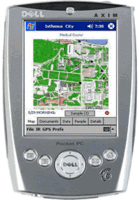What is Augmented Reality?
5.1. Defining Virtual and Augmented Reality
 Augmented Reality is a troublesome term for me because it seems too specifically defined. Whereas virtual reality suggests an immersive and interactive, entirely artificial environment, augmented reality seems to be increasingly defined by a digitally processed alteration of our visual and aural field of the settings we inhabit. When we think of virtual reality (Figure 1) we tend to think of people standing in safe space within a room wearing wired helmets and gloves feeling like they are flying or swimming or otherwise interacting in an environment that may have no sensory parallels to the space they are actually located (except for temperature and smells -- although this may soon change).
Augmented Reality is a troublesome term for me because it seems too specifically defined. Whereas virtual reality suggests an immersive and interactive, entirely artificial environment, augmented reality seems to be increasingly defined by a digitally processed alteration of our visual and aural field of the settings we inhabit. When we think of virtual reality (Figure 1) we tend to think of people standing in safe space within a room wearing wired helmets and gloves feeling like they are flying or swimming or otherwise interacting in an environment that may have no sensory parallels to the space they are actually located (except for temperature and smells -- although this may soon change).
 When we consider an augmented reality situation (Figure 2), we tend to imagine them walking around, still wearing helmets, visually and audibly aware of their physical space, but also noticing objects and events that are not physically occurring in those spaces. These understandings are more specific and specialized than the augmented reality gaming that I am interested in, which is gaming in augmented spaces -- regardless of the level of technology. At this broader definition, a single sheet of paper could be all the technology needed for a good augmented reality game. Perhaps we need to consider another name, and leave the term "augmented reality" to the tech-heavy researchers, but that is an argument for a future discussion.
When we consider an augmented reality situation (Figure 2), we tend to imagine them walking around, still wearing helmets, visually and audibly aware of their physical space, but also noticing objects and events that are not physically occurring in those spaces. These understandings are more specific and specialized than the augmented reality gaming that I am interested in, which is gaming in augmented spaces -- regardless of the level of technology. At this broader definition, a single sheet of paper could be all the technology needed for a good augmented reality game. Perhaps we need to consider another name, and leave the term "augmented reality" to the tech-heavy researchers, but that is an argument for a future discussion.
 Augmented Reality is a troublesome term for me because it seems too specifically defined. Whereas virtual reality suggests an immersive and interactive, entirely artificial environment, augmented reality seems to be increasingly defined by a digitally processed alteration of our visual and aural field of the settings we inhabit. When we think of virtual reality (Figure 1) we tend to think of people standing in safe space within a room wearing wired helmets and gloves feeling like they are flying or swimming or otherwise interacting in an environment that may have no sensory parallels to the space they are actually located (except for temperature and smells -- although this may soon change).
Augmented Reality is a troublesome term for me because it seems too specifically defined. Whereas virtual reality suggests an immersive and interactive, entirely artificial environment, augmented reality seems to be increasingly defined by a digitally processed alteration of our visual and aural field of the settings we inhabit. When we think of virtual reality (Figure 1) we tend to think of people standing in safe space within a room wearing wired helmets and gloves feeling like they are flying or swimming or otherwise interacting in an environment that may have no sensory parallels to the space they are actually located (except for temperature and smells -- although this may soon change).  When we consider an augmented reality situation (Figure 2), we tend to imagine them walking around, still wearing helmets, visually and audibly aware of their physical space, but also noticing objects and events that are not physically occurring in those spaces. These understandings are more specific and specialized than the augmented reality gaming that I am interested in, which is gaming in augmented spaces -- regardless of the level of technology. At this broader definition, a single sheet of paper could be all the technology needed for a good augmented reality game. Perhaps we need to consider another name, and leave the term "augmented reality" to the tech-heavy researchers, but that is an argument for a future discussion.
When we consider an augmented reality situation (Figure 2), we tend to imagine them walking around, still wearing helmets, visually and audibly aware of their physical space, but also noticing objects and events that are not physically occurring in those spaces. These understandings are more specific and specialized than the augmented reality gaming that I am interested in, which is gaming in augmented spaces -- regardless of the level of technology. At this broader definition, a single sheet of paper could be all the technology needed for a good augmented reality game. Perhaps we need to consider another name, and leave the term "augmented reality" to the tech-heavy researchers, but that is an argument for a future discussion.

0 Comments:
Post a Comment
<< Home